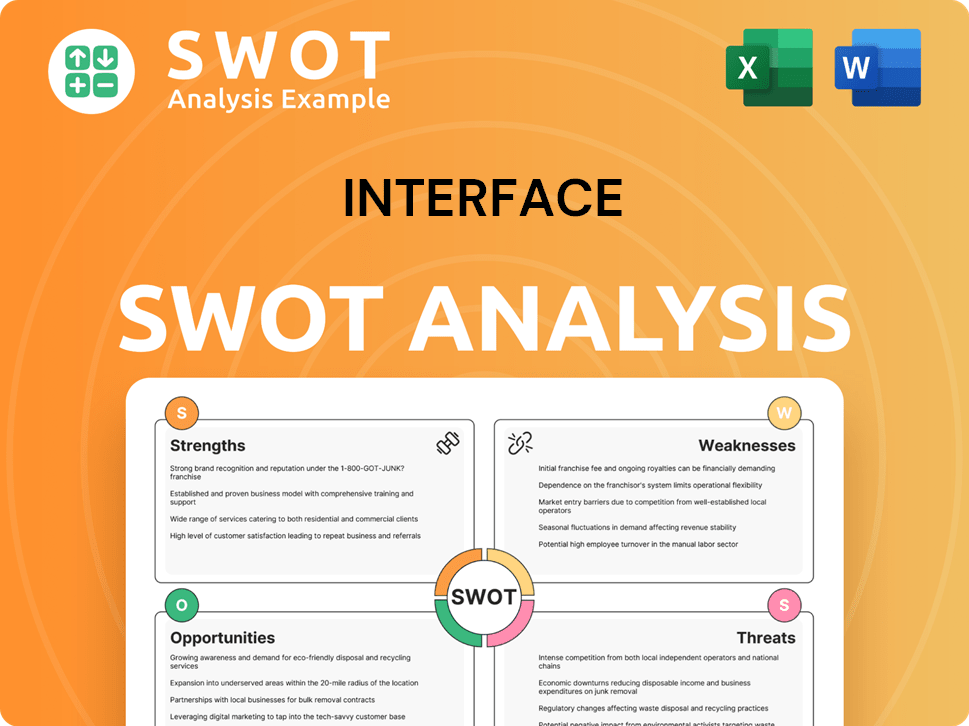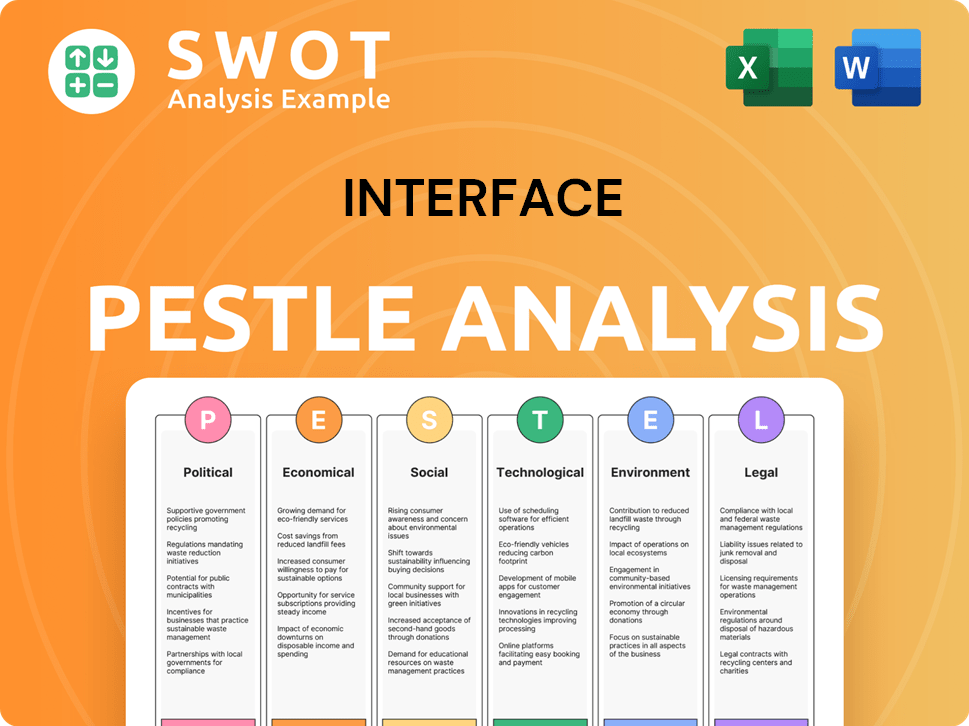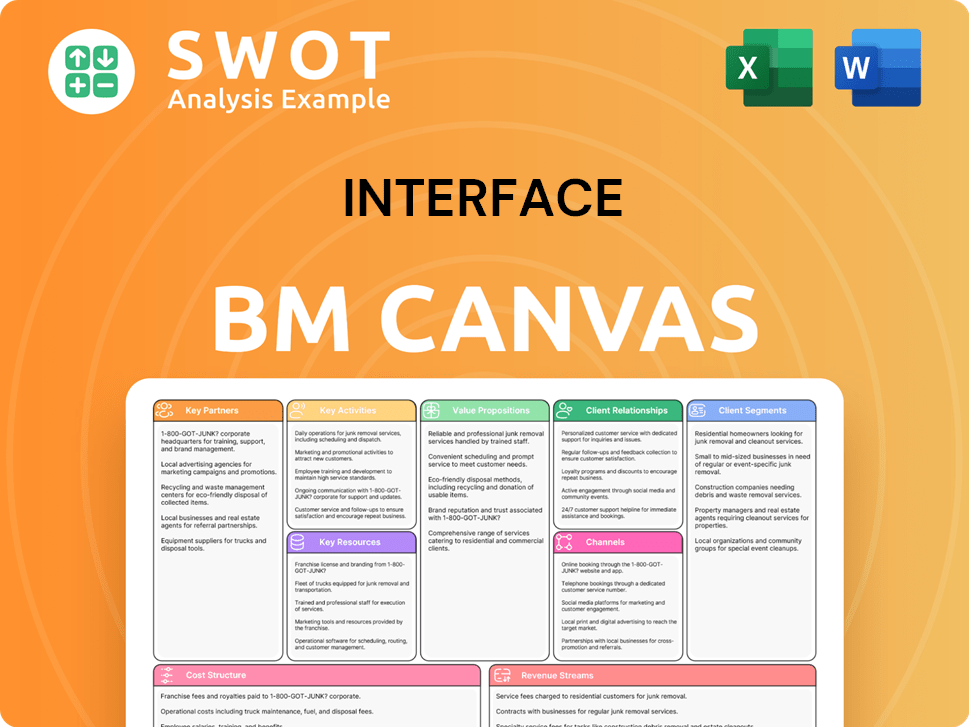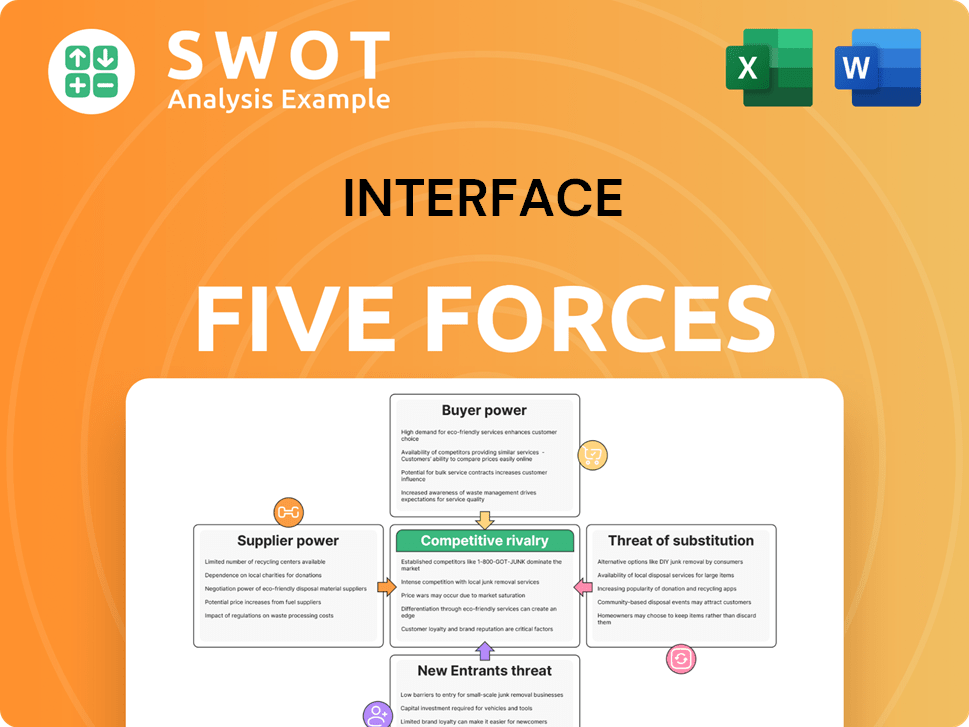Interface Bundle
How Did Interface Company Revolutionize Flooring?
Interface, Inc. isn't just a flooring company; it's a story of transformation. From its humble beginnings in 1973, Interface flooring has redefined the industry, embracing sustainability as a core value. This journey showcases how a company can evolve, driven by innovation and a commitment to environmental responsibility. Discover the pivotal moments that shaped Interface's path.

Interface's story began with modular carpet tiles, a groundbreaking concept that challenged traditional flooring methods. Founder Ray Anderson's 'Mission Zero' initiative marked a turning point, propelling Interface SWOT Analysis towards sustainable practices. This article will delve into the brief history of Interface flooring company, exploring its key milestones, product innovations, and lasting impact on the commercial flooring landscape, from its headquarters in LaGrange, Georgia, to its global presence today.
What is the Interface Founding Story?
The story of the Interface Company begins on November 16, 1973, when Ray C. Anderson, a textile industry veteran, established the company. Anderson saw a gap in the commercial flooring market and envisioned a better solution than traditional broadloom carpet. His goal was to create a more efficient and sustainable flooring option.
Anderson's vision led to the development of modular carpet tiles. This innovative approach addressed the inefficiencies of broadloom, where damage to a small area meant replacing the entire floor. Interface's modular tiles allowed for targeted replacements, reducing waste and installation time, which was a significant advantage in the commercial sector.
The initial funding for Interface came from Anderson's personal investment and a small group of associates. Before launching, Anderson conducted thorough research, including studying the European market, which was more advanced in carpet tile usage. This early research was crucial in shaping Interface's product development and market entry strategy. The company's innovative modular flooring concept found fertile ground in the 1970s, driven by the growing demand for flexible office spaces and efficient building solutions.
Interface's founding marked a shift in the commercial flooring industry, introducing a more sustainable and efficient alternative to traditional methods.
- Interface Company was founded by Ray C. Anderson in 1973.
- The company aimed to solve the inefficiencies of broadloom carpet.
- Early research, including studying the European market, influenced Interface's strategy.
- The initial product was a 50cm x 50cm carpet tile.
The company's initial business model focused on manufacturing and selling modular carpet tiles directly to commercial clients. Interface's first product was a 50cm x 50cm carpet tile, designed for durability and easy installation. This product was a key factor in the early success of the company. For more information on the company's ownership and stakeholders, you can read about the Owners & Shareholders of Interface.
Interface SWOT Analysis
- Complete SWOT Breakdown
- Fully Customizable
- Editable in Excel & Word
- Professional Formatting
- Investor-Ready Format

What Drove the Early Growth of Interface?
The early growth of the Interface Company was marked by its efforts to introduce modular carpet tiles, challenging the dominance of broadloom. Initial product development focused on enhancing durability, aesthetics, and ease of installation, targeting corporate offices, healthcare facilities, and educational institutions. Securing early clients demonstrated the long-term cost savings and operational benefits of modular flooring. The company's early focus was on establishing itself in the commercial flooring market.
Early product launches by Interface focused on refining carpet tile design for durability, aesthetics, and ease of installation. These improvements were crucial for targeting key markets such as corporate offices, healthcare facilities, and educational institutions. The company's strategy involved demonstrating the long-term cost savings and operational benefits of modular flooring to secure its first major clients. This approach helped establish Interface in the commercial flooring sector.
Interface's early team expansion involved building a dedicated sales force and establishing manufacturing capabilities in LaGrange, Georgia. This strategic investment in infrastructure and personnel was vital for supporting initial market penetration and growth. The development of these core competencies allowed the company to effectively manage its operations and meet increasing demand. These steps were crucial for the company's early success in the modular flooring market.
Interface expanded into new markets by establishing distribution networks across the United States and then internationally, particularly in Europe. A significant strategic move was the 1987 acquisition of Heuga, a Dutch carpet tile manufacturer. This acquisition significantly expanded Interface's global footprint and technological capabilities, solidifying its position as a global leader in the modular carpet industry. In the late 1980s and early 1990s, the company saw steady revenue growth due to the increasing acceptance of modular carpet tiles.
The market reception for modular carpet tiles gradually improved as clients recognized their practical advantages. Interface navigated a competitive landscape by emphasizing product quality, design flexibility, and customer service. Strategic shifts during this period included a greater focus on design innovation and expanding the range of patterns and colors to appeal to a broader client base. Leadership transitions focused on strengthening management teams to support global expansion.
Interface PESTLE Analysis
- Covers All 6 PESTLE Categories
- No Research Needed – Save Hours of Work
- Built by Experts, Trusted by Consultants
- Instant Download, Ready to Use
- 100% Editable, Fully Customizable

What are the key Milestones in Interface history?
The Interface Company's journey is marked by significant achievements and transformative challenges, establishing its legacy in the Interface flooring industry. The company's history is a testament to its commitment to innovation, sustainability, and adaptation within the commercial flooring market.
| Year | Milestone |
|---|---|
| 1973 | Interface Company was founded by Ray Anderson, marking the beginning of its journey in the flooring industry. |
| 1994 | 'Mission Zero' was launched, a groundbreaking commitment to eliminate any negative impact on the environment by 2020, setting new standards for sustainable flooring. |
| 2003 | The company introduced its first closed-loop recycling system for carpet tiles, showcasing its dedication to circular economy principles. |
| 2010 | Net-Works, a program repurposing discarded fishing nets into carpet tile yarn, was launched, addressing both environmental and social issues. |
| 2018 | Interface Company acquired nora systems, expanding its product portfolio to include rubber flooring and increasing its global presence. |
Interface Company has consistently pushed boundaries with its innovations. A key focus has been on developing modular flooring solutions that are both environmentally friendly and high-performing, setting it apart in the industry.
The development of recycled content backing for carpet tiles was a significant innovation, reducing waste and promoting sustainability. This initiative helped to decrease the reliance on virgin materials.
Interface Company pioneered closed-loop recycling systems for carpet, enabling the recycling of old carpet tiles into new ones. This process significantly reduces waste and conserves resources.
The Net-Works program, which transforms discarded fishing nets into carpet tile yarn, addresses both environmental and social challenges. This initiative supports local communities and reduces ocean pollution.
Interface Company has consistently focused on reducing energy consumption and waste in its manufacturing processes. This commitment has led to significant improvements in its environmental footprint.
Expanding the product portfolio to include luxury vinyl tile (LVT) and nora® rubber flooring through acquisitions has diversified revenue streams. This strategic move has broadened market reach.
Interface Company has secured numerous patents related to carpet tile construction, adhesive systems, and recycling processes. These innovations protect its intellectual property and competitive advantage.
Despite its successes, Interface Company has faced several challenges. Market downturns and economic recessions have impacted demand within the commercial construction sector, requiring the company to adapt and innovate.
Economic recessions have negatively impacted the demand for commercial construction and flooring. This has required Interface Company to adjust its strategies to mitigate the effects of these downturns.
Competition from traditional broadloom manufacturers and other modular flooring companies has necessitated continuous innovation. This has driven Interface Company to differentiate its products and services.
Initial skepticism from customers and the industry regarding the feasibility and cost-effectiveness of sustainable manufacturing practices was a challenge. Interface Company addressed this through education and transparent reporting.
Global events and economic fluctuations have caused supply chain disruptions, affecting the availability of raw materials and increasing production costs. Interface Company has worked to mitigate these risks.
Evolving consumer preferences and a growing demand for sustainable products have required Interface Company to adapt its product offerings and marketing strategies. This has led to a focus on innovation.
Inflation and rising operational costs have put pressure on profitability. Interface Company has focused on efficiency improvements and strategic pricing to navigate these challenges.
Interface Business Model Canvas
- Complete 9-Block Business Model Canvas
- Effortlessly Communicate Your Business Strategy
- Investor-Ready BMC Format
- 100% Editable and Customizable
- Clear and Structured Layout

What is the Timeline of Key Events for Interface?
The Interface Company, a prominent player in the flooring industry, has a rich history marked by innovation and a strong commitment to sustainability. Founded in 1973 by Ray C. Anderson, the company initially focused on modular carpet tiles. Over the years, it has expanded its global presence and product offerings, consistently pioneering sustainable practices. From its early manufacturing days to its ambitious environmental goals, Interface has evolved into a leader in the commercial flooring sector, setting benchmarks for eco-friendly manufacturing and design.
| Year | Key Event |
|---|---|
| 1973 | Ray C. Anderson founded Interface. |
| 1974 | Began manufacturing modular carpet tiles in LaGrange, Georgia. |
| 1987 | Acquired Heuga, a European carpet tile manufacturer, expanding global presence. |
| 1994 | Ray Anderson announced 'Mission Zero,' committing to eliminate environmental impact by 2020. |
| 1995 | Introduced the first carpet tile with recycled content backing. |
| 2000s | Continued to innovate in recycling and sustainable manufacturing processes. |
| 2011 | Ray Anderson passed away; company continued his legacy. |
| 2016 | Launched the Net-Works program. |
| 2018 | Acquired nora® systems, a leading manufacturer of premium rubber flooring, expanding product portfolio. |
| 2020 | Achieved Mission Zero goals, becoming a carbon-neutral enterprise globally. |
| 2022 | Interface reported net sales of $1.28 billion. |
| 2023 | Interface celebrated 50 years of innovation and sustainability. |
| 2024 | Continues to focus on carbon negative products and circular economy initiatives. |
Interface is deeply committed to its 'Climate Take Back' mission. This involves creating products and processes that have a positive environmental impact, going beyond carbon neutrality. The company aims to reverse global warming through its sustainable initiatives. This commitment drives innovation in sustainable flooring solutions.
Interface plans to expand its product offerings in Luxury Vinyl Tile (LVT) and nora® rubber flooring. This expansion aligns with the growing market demand for diverse and sustainable flooring options. The company's strategic growth includes broadening its portfolio to meet various customer needs.
Interface is actively integrating circular economy principles into its business model. This includes developing new materials with lower embodied carbon. Enhancing recycling infrastructure is a key focus. This approach aims to minimize waste and maximize resource utilization.
The company anticipates significant impacts from industry trends. These include the increasing demand for healthy building materials. Stringent environmental regulations will also shape its future. These factors are expected to drive growth and innovation.
Interface Porter's Five Forces Analysis
- Covers All 5 Competitive Forces in Detail
- Structured for Consultants, Students, and Founders
- 100% Editable in Microsoft Word & Excel
- Instant Digital Download – Use Immediately
- Compatible with Mac & PC – Fully Unlocked

Related Blogs
- What is Competitive Landscape of Interface Company?
- What is Growth Strategy and Future Prospects of Interface Company?
- How Does Interface Company Work?
- What is Sales and Marketing Strategy of Interface Company?
- What is Brief History of Interface Company?
- Who Owns Interface Company?
- What is Customer Demographics and Target Market of Interface Company?
Disclaimer
All information, articles, and product details provided on this website are for general informational and educational purposes only. We do not claim any ownership over, nor do we intend to infringe upon, any trademarks, copyrights, logos, brand names, or other intellectual property mentioned or depicted on this site. Such intellectual property remains the property of its respective owners, and any references here are made solely for identification or informational purposes, without implying any affiliation, endorsement, or partnership.
We make no representations or warranties, express or implied, regarding the accuracy, completeness, or suitability of any content or products presented. Nothing on this website should be construed as legal, tax, investment, financial, medical, or other professional advice. In addition, no part of this site—including articles or product references—constitutes a solicitation, recommendation, endorsement, advertisement, or offer to buy or sell any securities, franchises, or other financial instruments, particularly in jurisdictions where such activity would be unlawful.
All content is of a general nature and may not address the specific circumstances of any individual or entity. It is not a substitute for professional advice or services. Any actions you take based on the information provided here are strictly at your own risk. You accept full responsibility for any decisions or outcomes arising from your use of this website and agree to release us from any liability in connection with your use of, or reliance upon, the content or products found herein.